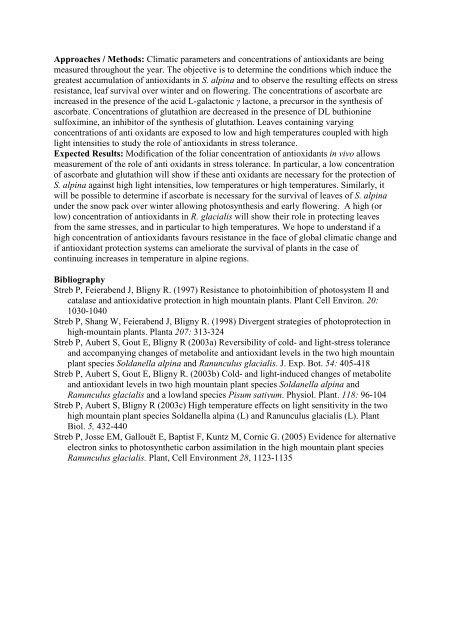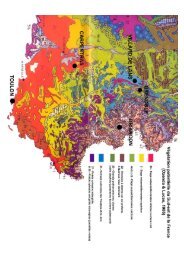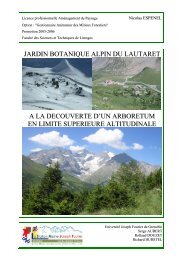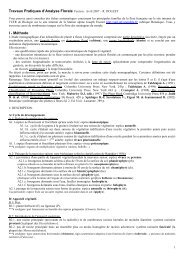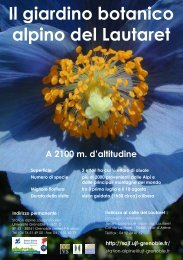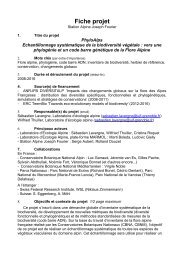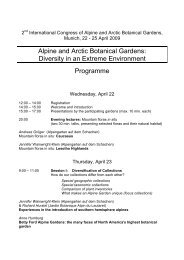Rannunculus Anglais - Station Alpine Joseph Fourier
Rannunculus Anglais - Station Alpine Joseph Fourier
Rannunculus Anglais - Station Alpine Joseph Fourier
You also want an ePaper? Increase the reach of your titles
YUMPU automatically turns print PDFs into web optimized ePapers that Google loves.
Approaches / Methods: Climatic parameters and concentrations of antioxidants are being<br />
measured throughout the year. The objective is to determine the conditions which induce the<br />
greatest accumulation of antioxidants in S. alpina and to observe the resulting effects on stress<br />
resistance, leaf survival over winter and on flowering. The concentrations of ascorbate are<br />
increased in the presence of the acid L-galactonic γ lactone, a precursor in the synthesis of<br />
ascorbate. Concentrations of glutathion are decreased in the presence of DL buthionine<br />
sulfoximine, an inhibitor of the synthesis of glutathion. Leaves containing varying<br />
concentrations of anti oxidants are exposed to low and high temperatures coupled with high<br />
light intensities to study the role of antioxidants in stress tolerance.<br />
Expected Results: Modification of the foliar concentration of antioxidants in vivo allows<br />
measurement of the role of anti oxidants in stress tolerance. In particular, a low concentration<br />
of ascorbate and glutathion will show if these anti oxidants are necessary for the protection of<br />
S. alpina against high light intensities, low temperatures or high temperatures. Similarly, it<br />
will be possible to determine if ascorbate is necessary for the survival of leaves of S. alpina<br />
under the snow pack over winter allowing photosynthesis and early flowering. A high (or<br />
low) concentration of antioxidants in R. glacialis will show their role in protecting leaves<br />
from the same stresses, and in particular to high temperatures. We hope to understand if a<br />
high concentration of antioxidants favours resistance in the face of global climatic change and<br />
if antioxidant protection systems can ameliorate the survival of plants in the case of<br />
continuing increases in temperature in alpine regions.<br />
Bibliography<br />
Streb P, Feierabend J, Bligny R. (1997) Resistance to photoinhibition of photosystem II and<br />
catalase and antioxidative protection in high mountain plants. Plant Cell Environ. 20:<br />
1030-1040<br />
Streb P, Shang W, Feierabend J, Bligny R. (1998) Divergent strategies of photoprotection in<br />
high-mountain plants. Planta 207: 313-324<br />
Streb P, Aubert S, Gout E, Bligny R (2003a) Reversibility of cold- and light-stress tolerance<br />
and accompanying changes of metabolite and antioxidant levels in the two high mountain<br />
plant species Soldanella alpina and Ranunculus glacialis. J. Exp. Bot. 54: 405-418<br />
Streb P, Aubert S, Gout E, Bligny R. (2003b) Cold- and light-induced changes of metabolite<br />
and antioxidant levels in two high mountain plant species Soldanella alpina and<br />
Ranunculus glacialis and a lowland species Pisum sativum. Physiol. Plant. 118: 96-104<br />
Streb P, Aubert S, Bligny R (2003c) High temperature effects on light sensitivity in the two<br />
high mountain plant species Soldanella alpina (L) and Ranunculus glacialis (L). Plant<br />
Biol. 5, 432-440<br />
Streb P, Josse EM, Gallouët E, Baptist F, Kuntz M, Cornic G. (2005) Evidence for alternative<br />
electron sinks to photosynthetic carbon assimilation in the high mountain plant species<br />
Ranunculus glacialis. Plant, Cell Environment 28, 1123-1135


